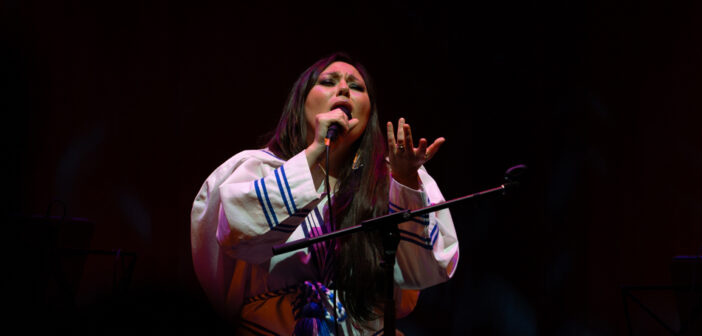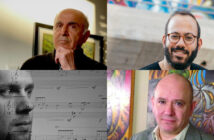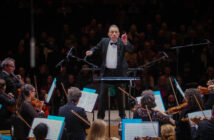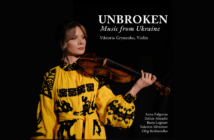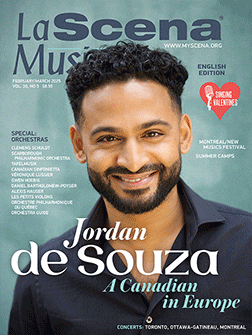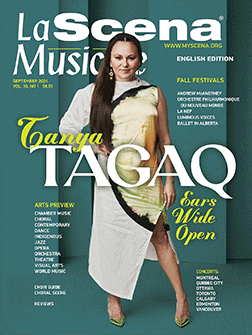
This page is also available in / Cette page est également disponible en:
![]() Francais (French)
Francais (French)
Tanya Tagaq has her ears open to the world around her. She is listening. From her home in Ikaluktutiak (Cambridge Bay, Nunavut), where the season of 24-hour sun is coming to an end, she describes how she hears. “It’s hard to explain,” she says. “My relationship with sound is a strange one, sometimes sound makes sense, and sometimes it doesn’t. If I’m not paying attention; sometimes all the sounds will come together, flatten …I end up composing from that. When sounds get compressed, they’ll turn into songs, or shapes—I don’t really have a lot of control over when or how that happens, but sometimes those ideas will stick with me. That’s usually how I end up with albums, or with repetitive elements of my improvised performances. The crows were just arguing outside my window,” she observes; “it’s easy to make songs out of that.”
This way of observing and engaging with the sounds around her is unintentional, she says—it’s part of who she has always been. “When I was a kid, I remember throwing rocks at a metal dump just to hear the different sound.” It wasn’t until much later that she was making music.
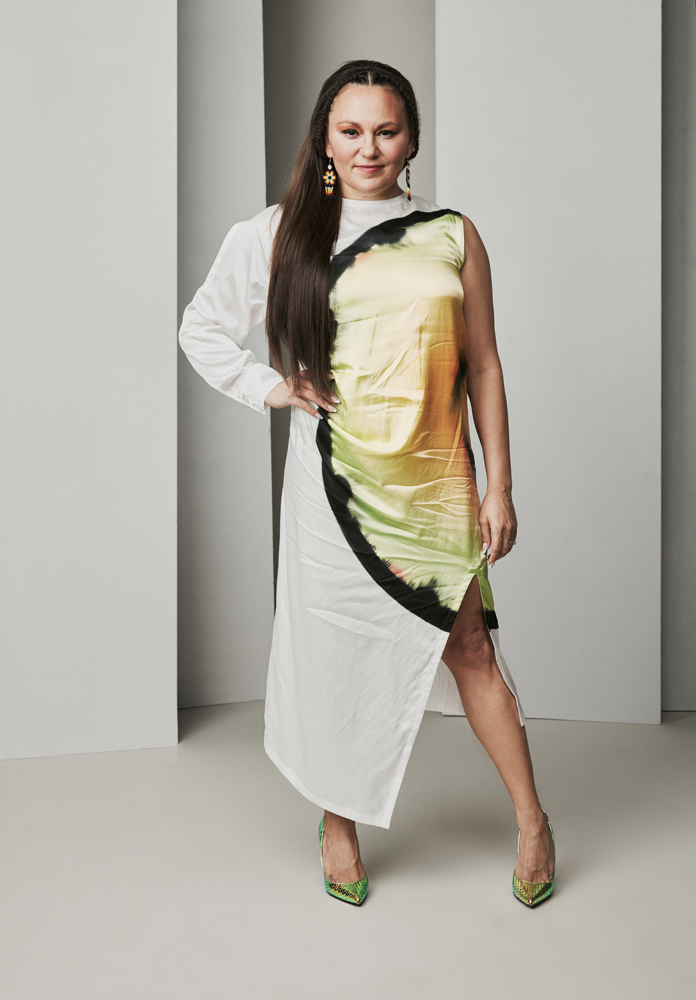
Tanya Tagaq, by Carlyle Routh
Finding Music
Tanya Tagaq grew up in Ikaluktutiak, where she lived until she was sent to residential school in Sǫǫmbak’è (Yellowknife). She later went on to study fine arts at the Nova Scotia College of Art and Design (NSCAD), in Kjipuktuk (Halifax). “I used to want to sing, but I didn’t know how,” she says. “I always loved dancing; I always loved music. At NSCAD, in the early 1990s, I started really enjoying moving to music. That’s when I started expressing myself vocally.”

Tanya Tagaq, Photo by Mike Clark
In 2005, Tagaq released her debut album, Sinaa. She has since released several others, including the Juno Award- and Polaris Music Prize-winning Animism (2014), and critically acclaimed Retribution (2016). She has been described by Rolling Stone magazine as “one of the avant-garde’s most dynamic performers,” has received multiple Juno, Polaris Prize, and Canadian Aboriginal Music Award nominations, and is a member of the Order of Canada. Beyond her work as a performer, Tagaq is a composer, an activist, and an author. She is also a mother.
Constant Collaboration
Her career has been marked by a wide range of hugely successful collaborations, perhaps most famously an early partnership with Icelandic popular musician Björk. “I love collaborating,” she says. “It’s almost like there’s a territory—an emotional territory, or a sonic territory. You create your territory on your own, but when I collaborate with somebody and they bring something different, it pulls my voice and my ideas into a different dimension. It creates more room; it makes the territory larger. It’s so exciting. It pushes you into places you wouldn’t have gone alone. I think that’s the potency of collaboration—that forced learning that comes with the freshness of someone else’s interpretation of what’s happening.” She describes the process of choosing collaborators as being quite organic—a matter of “meeting people you click with, who you trust. It’s a very intimate relationship. Who they are is so important.”
In 2005, she met and clicked with violinist David Harrington, and began working with the Kronos Quartet (David Harrington and Gabriela Díaz, violins; Ayane Kozasa, viola; and Paul Wiancko, cello). Harrington “helped me realize that I am a composer, and not just an ingredient in someone else’s composition,” she says. “I love working with Kronos. It’s such a delight to be recognized by such an innovative and exciting group.”
The Kronos Quartet have performed with Tagaq all across North America. In 2015, they commissioned her to write a piece for their Fifty for the Future project. “They are always pushing the boundaries of what classical music is. When you’re from a minority culture, it can be very easy to get eaten up by the classical music scene. David Harrington was very adamant about my talent—that it has an essence to it that cannot be replicated by anything or anyone other than an Inuk person. I love the respect that comes from them.”
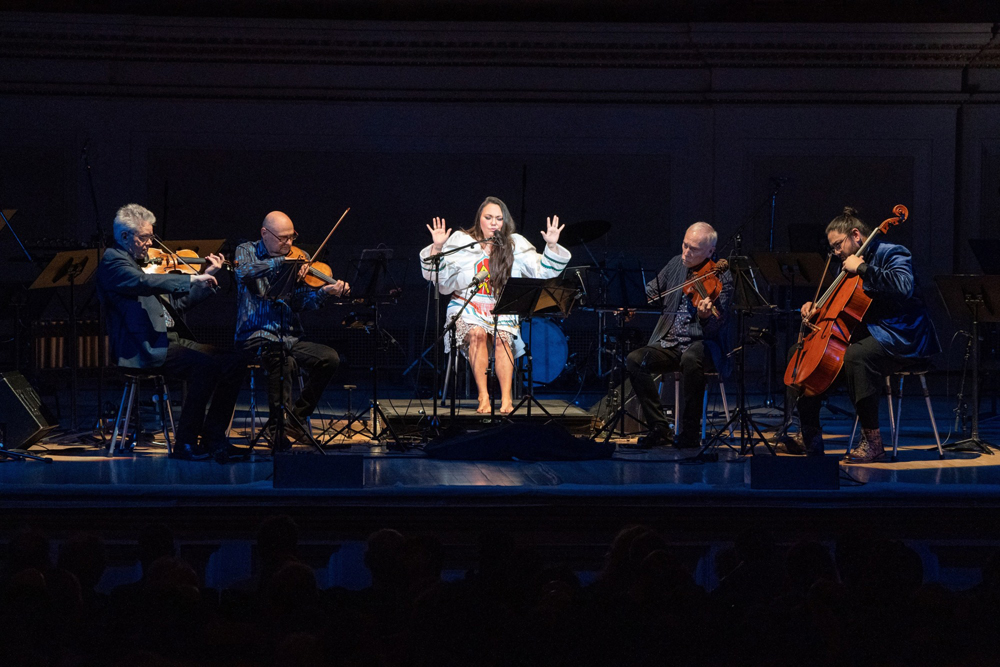
Kronos Quartet and Tanya Tagaq at Stern Auditorium, Carnegie Hall (November 2023), Photo credit Stephanie Berger
Tagaq’s love of and openness to collaboration has resulted in a career marked by unparalleled creativity and artistic variety. “There’s not a lot of deliberation in my work,” she admits. “I’m just living.” She adds: “It’s like I’m walking on the tundra, and I’ll stumble across a certain plant that I’ve never seen before. It’s just discovery.” Her work is hard to define: “There’s a lack of genre in what I’m doing, because there’s a lack of genre in my senses—a smell will remind me of a sound, will remind me of something I’ve seen, or something that I’ve thought. They really talk to each other.
“I think that’s how it is for a lot of people,” she says. What is perhaps special about Tagaq, then, is the courage with which she communicates these connections through her art. “It’s about not caring what people think, and making art because I feel like it’s work that already exists in the universe, and all I have to do is put it out there. All my work feels like that; it’s not me, it’s just there—I’m just observing.”
Orchestral Vibrations
Tagaq admits that sometimes the bravery required to make things for public consumption doesn’t yield the results she wants. This doesn’t stop her from exploring though, and embarking on new projects of all shapes and sizes. She has collaborated with symphony orchestras, for example, on a number of occasions. “Orchestral work is so delicious,” she says. “It’s like a bowl of warm s’mores: it’s crunchy and hot, melting. When you’re standing near an orchestra there’s so much great sound; it’s direct, and alive—like grass growing roots, all connected together. It feels so good to feel the vibrations from the instruments.”
On Oct. 1, Tagaq will perform Qiksaaktuq, with the Royal Conservatory Orchestra, and conductors Christine Duncan and Jennifer Tung, as part of an event commemorating the National Day for Truth and Reconciliation, at Koerner Hall in Tkaronto (Toronto).
Qiksaaktuq, the title of the piece, is an Inuktitut word for grief. Written by Tagaq, Christine Duncan and Jean Martin, the piece was originally commissioned by the Toronto Symphony Orchestra, back in 2017. “We wanted to do a piece centred around how to process grief,” says Tagaq. “In Indigenous communities, there is a lot of trauma, and it’s easy for sound to be a conduit for the feelings that need processing so that you can remain buoyant, strong and diligent. One of those feelings is grief.” The five movements (a nod to the five stages of the Kübler-Ross model for processing grief) combine an orchestral score, written by Jean Martin, which will be conducted by Jennifer Tung, with an improvised brass section, created and led by Christine Duncan—and, finally, Tagaq’s improvised vocals.
In performance, Tagaq reacts to the sounds that are happening around her—sometimes even able to anticipate what’s coming next. Duncan, who has been one of Tagaq’s collaborators for many years, has devised a system of hand cues with which she conducts the improvised brass part. In rehearsal, she takes the players through these cues, and introduces them to the largely textural sounds they are bringing to the piece, which are somewhat “unusual for a symphonic performance,” Duncan admits.
“It’s a really interesting hybrid with the through-composed structure, and these elements that are totally improvised,” the conductor says, explaining that the brass ensemble acts as a middle ground between the notated orchestral elements and Tagaq’s virtuosic, un-conducted improvisation. “In this musical parfait, the three layers are complementary, and inform each other.”
Duncan adds: “I don’t know of any other pieces that have two conductors on stage.” Jennifer Tung, who will also be conducting, looks forward to preparing a piece that is necessarily “different every time.” No stranger to contemporary music, Tung sees her role as one of navigating communication between these three elements, and seeing to it that the performance lives up to Duncan, Martin, and Tagaq’s vision. “One of the best things about working on contemporary music is getting to ask the composers questions,” she says. “It’s a really collaborative process.”
Curated by creative director and producer Denise Bolduc, and hosted by CBC’s Falen Johnson, the evening will also include performances by the Manitou Mkwa Singers; Emma Pennell, a Mi’kmaw two-spirit soprano and Glenn Gould School (GGS) student; and GGS faculty pianist David Eliakis. The music will be paired with an Indigenous marketplace, which will be open to the public before and after the concert, as well as an opening prayer and elder testimony directly preceding the performance.
This marks the RCM’s third annual event commemorating the Truth and Reconciliation commission, having previously featured headlining artists writer Thomson Highway and composer Andrew Balfour. The project’s goal has remained the same since its inception, says Mervon Mehta, RCM’s executive director of performing arts: “To not shy away from the truth; to make space for telling stories.” Mehta recalls he was particularly excited about Tagaq’s participation in this year’s event, describing her as “one of the most interesting and individual artists that I have ever met.” He hopes audiences of Indigenous and non-Indigenous people alike will leave with “new knowledge, a level of shared understanding, laughs, tears, and hope.”
On Reconciliation
Reconciliation is a contested and complicated term. While some accept it as representing good relations between Indigenous people and settler communities, others see it as inadequate, or even counterproductive to the more demanding forms of repair necessary to achieve just relations between Indigenous people, settler descendents, and governments. Then, of course there are countless perspectives that live between these two polarities. As an artist, activist, and Indigenous woman, this is something that Tagaq thinks about a great deal.
“There’s a lot of talk about what reconciliation is,” she says, but the “rhetoric, good and bad” risks distracting from the pressing need for action—for “specific infrastructure (medical systems, legal systems, educational systems) that addresses the socioeconomic conditions of Indigenous people, which have been created by generations of trauma.”
“People need to understand that the relationship between Indigenous people and the Canadian government is a horrific, abusive one,” she continues. “A lot of people still don’t know about the constitution, the treaty system, the money owed to Indigenous communities.” The result, she says, is a lack of compassion. “Canadians need to understand that reconciliation is not just a benevolent act. Indigenous people are owed.”
Tagaq shares that the relationship between her work, her activism, and her life is one of those things she wonders about often. The connection between the three is “not an intentional thing,” she says. “I’m hurting, so I make a piece because I’m hurting. It’s not an observation; I’m living it. It’s a symptom, if anything.” A positive symptom, she adds: “Art work can be used to bring awareness,” and hopefully, lead to steps toward reparations and meaningful action.
It Bears Repeating
Perhaps surprisingly, the multi-talented artist’s next project is not a musical one. During the COVID-19 pandemic and ensuing lockdowns, Tagaq took a break from music. “For 20 years, I was on a plane constantly. But then, I was with my children, I was at home, and it was a very sweet place to be.” Among the results of this time is a series of children’s books, the first of which comes out in September. She has taken great joy in expressing herself in this form: “I am a mother, and that’s something I don’t often get to express. This part of me is bigger than any of the other ones—my love is bigger than any other part of me.” It Bears Repeating, with illustrations by Cee Pootoogook, is a counting book for children, written in Inuktitut. “It’s for that lovely stage of learning how to count, when children are just working so hard to get the words out. I love that stage so much.” Her second children’s book will be published next year.
It Bears Repeating is available for purchase now. www.tanyatagaq.com
Tanya Tagaq will perform at Koerner Hall on Oct. 1, 2024. www.rcmusic.com/events-and-performances/commemorate-truth-reconciliation-with-tanya-tagaq
This page is also available in / Cette page est également disponible en:
![]() Francais (French)
Francais (French)

